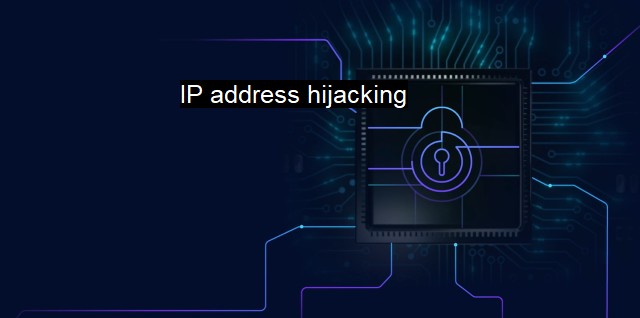What is IP address hijacking?
The Rising Threat of IP Address Hijacking in the Digital Age: An Exploration of Its Exploitation of TCP/IP and Significance for Internet Users Worldwide
IP address hijacking, with is a form of attack whereby an individual or entity illegitimately takes control of or manipulates Internet Protocol (IP) addresses which are not originally assigned to them. These could either be IP addresses belonging to other users or those unassigned and floating in cyberspace. Central to the operation of the internet, IP addresses serve as distinct identifiers for devices and systems globally interconnected through the sophisticated web of the internet.The criminal action of IP address hijacking, sometimes referred to as IP hijacking, BGP hijacking, or prefix hijacking, has long plagued the internet community, with attackers exploiting the pivotal role of IP addresses in connecting and communicating over the internet. The gravity of the threat it poses necessitates robust cybersecurity measures and antivirus solutions; it's not just an act of theft - it's an invasion into the privacy and operation of organizations and individuals.
Cyberattackers resort to IP address hijacking primarily from malicious intent to deceive or exploit, utilizing different techniques to succeed in their heinous adventures. At a simplistic level, attackers can change the IP address of an innocent user to an already blacklisted IP address. This action can disrupt the otherwise legitimate user's internet-based activities or even implicate them in illicit operations online.
Such attacks are a direct strike at the inherent trust established by the Border Gateway Protocol (BGP), which governs the routing of all online traffic. The protocol assumes that all active routers in the network are trustworthy, with no built-in security features to authenticate or verify the legitimacy of IP routes. Attackers explot this weakness to spread disinformation through spoofing or presenting false information to manipulate online traffic.
BGP hijacking, another form of IP address hijacking, involves an attacker rerouting internet traffic to alternative (often malicious) destinations by falsely declaring to be the rightful owner of the IP address block. The attacker diverts the traffic via a visitor-friendly facade often replicating legitimate websites to pilfer unsuspecting users' data or propagate malware.
A form of cyberattack as disruptive as this, mandates robust countermeasures integrating measures into the entire cybersecurity strategy, including antivirus applications. Antivirus applications, for instance, provide real-time protection against potential threats. They leverage sophisticated algorithms to identify abnormal behaviors and defend against them promptly. Most importantly, these programs upgrade regularly to cope with new forms of IP hijack techniques, forming the front line of defense against these challenges.
Amid the risks that IP address hijacking pose, businesses and individuals need to employ additional precautions. Network operators should validate ownership of their IP addresses globally across the internet community. using secure protocols that offer safety through encryption like Transport Layer Security (TLS) is crucial. Employing anti-spoofing measures and implementing a network intrusion detection system (NIDS) can also provide useful tools for defense. Training employees about the importance of security and how to handle suspicious activities can also enhance the security of an organization.
The cybersecurity community needs to continually combat and succeed against IP address hijacking, one of the most significant threats cybersecurity faces. It demands the incorporation of protective strategies and technologies like antivirus software and vigilance from the entire online community to prevent interruptions, ensuring the internet's smooth operation and maintaining trust in global digital communications. Public and private stakeholders need to collaborate to develop and implement proactive technologies and policies to protect against such threats. Action on this front, rooted in vigilance and invention, cannot be delayed and must be encouraged and undertaken with urgency.

IP address hijacking FAQs
What is IP address hijacking?
IP address hijacking is a type of cyber attack where an attacker takes control of a victim's IP address and uses it for malicious purposes. This can include conducting fraudulent activities, launching attacks on other systems, or stealing sensitive information.How does IP address hijacking occur?
IP address hijacking can occur through a variety of methods, including malware infections, phishing attacks, and exploiting vulnerabilities in software or network infrastructure. Attackers may also use tools such as IP spoofing to impersonate a legitimate IP address and gain access to a network.What are the consequences of IP address hijacking?
The consequences of IP address hijacking can include loss of sensitive data, financial loss, reputation damage, and legal repercussions. In addition, if an attacker is able to use a hijacked IP address to conduct attacks on other systems, they may be able to cause widespread damage and disruption.How can I protect myself against IP address hijacking?
To protect yourself against IP address hijacking, it is important to keep your software and systems up to date with the latest security patches, use strong passwords and two-factor authentication, and be cautious of suspicious emails and links. It is also important to use reputable antivirus and security software to help detect and prevent attacks. Finally, educate yourself on the latest threats and regularly review your network activity to detect any unusual behavior.| | A | | | B | | | C | | | D | | | E | | | F | | | G | | | H | | | I | | | J | | | K | | | L | | | M | |
| | N | | | O | | | P | | | Q | | | R | | | S | | | T | | | U | | | V | | | W | | | X | | | Y | | | Z | |
| | 1 | | | 2 | | | 3 | | | 4 | | | 7 | | | 8 | | |||||||